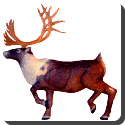 Caribou — The reindeer, known as caribou when wild in North America, is an Arctic and Subarctic-dwelling deer (Rangifer tarandus).
Caribou — The reindeer, known as caribou when wild in North America, is an Arctic and Subarctic-dwelling deer (Rangifer tarandus).
The weight of a female varies between 60 and 170 kg (132 – 375 lb). In some subspecies of reindeer, the male is slightly larger; in others, the male can weigh up to 300 kg (661 lb). Both sexes grow antlers, which (in the Scandinavian variety) for old males fall off in December, for young males in the early spring, and for females, summer. The antlers typically have two separate groups of points , a lower and upper. Domesticated reindeer are shorter-legged and heavier than their wild counterparts.
Reindeer have specialized noses featuring nasal turbinate bones that dramatically increase the surface area within the nostrils. Incoming cold air is warmed by the animal’s body heat before entering the lungs, and water is condensed from the expired air and captured before the deer’s breath is exhaled, used to moisten dry incoming air and possibly absorbed into the blood through the mucous membranes.
Reindeer hooves adapt to the season: in the summer, when the tundra is soft and wet, the footpads become spongy and provide extra traction. In the winter, the pads shrink and tighten, exposing the rim of the hoof which cuts into the ice and crusted snow to keep the animal from slipping. This also enables them to dig down (an activity known as “cratering”) through the snow to their favorite food, a lichen known as reindeer moss.
The reindeer coat has two layers of fur, a dense woolly undercoat and longer-haired overcoat consisting of hollow, air-filled hairs.
Reindeer are ruminants, having a four-chambered stomach. They mainly eat lichens in winter, especially reindeer moss. However, they also eat the leaves of willows and birches, as well as sedges and grasses. There is some evidence to suggest that on occasion they will also feed on lemmings, arctic char, and bird eggs.
 Kids Portal For Parents India Kids Network
Kids Portal For Parents India Kids Network






